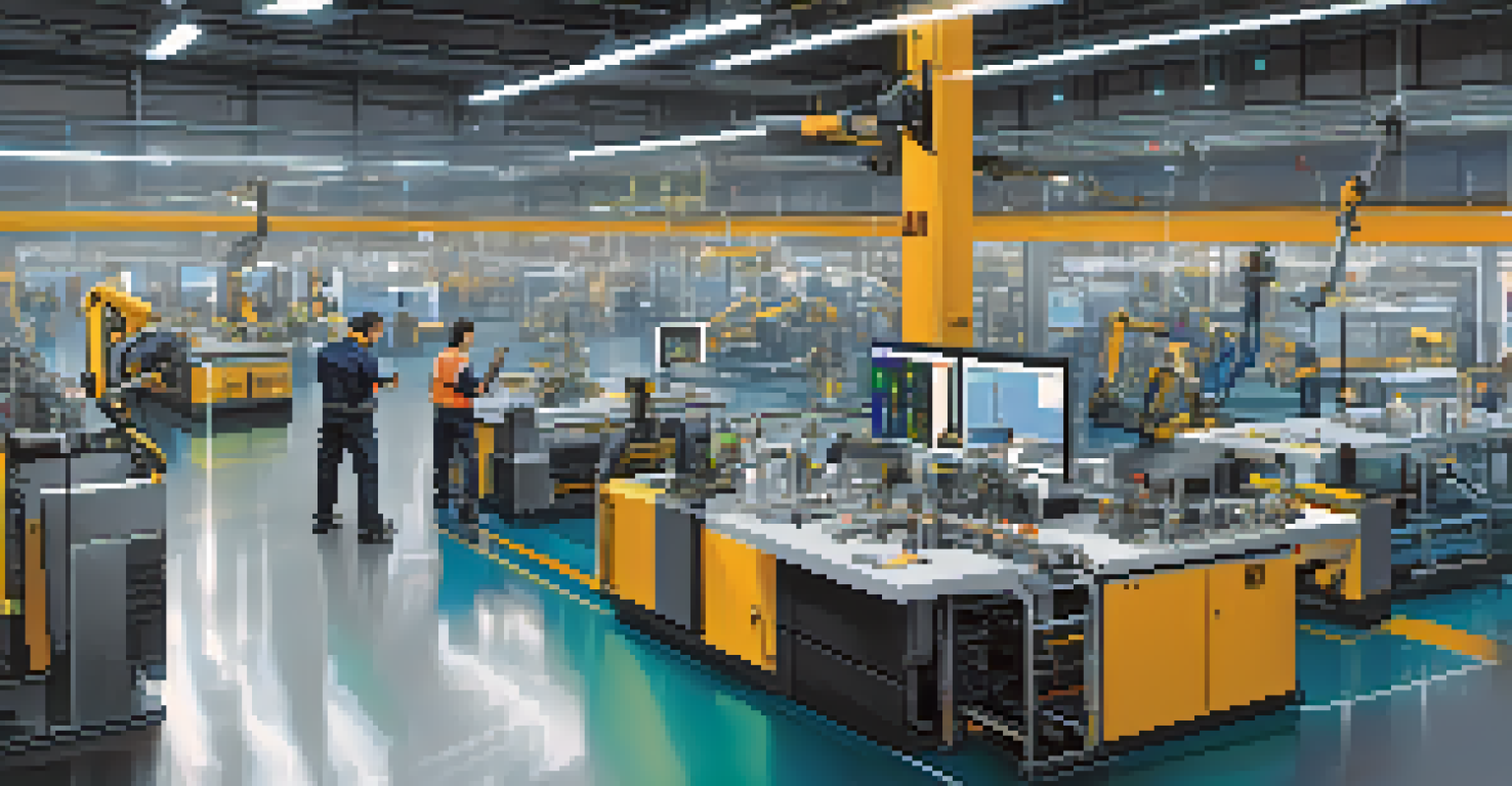Future Trends in Edge AI: What to Expect in Coming Years

The Rise of Distributed Computing in Edge AI
Distributed computing is transforming how we process data, bringing computation closer to the data source. This shift allows devices to analyze information in real-time, reducing latency and improving responsiveness. Imagine a smart camera that can instantly detect anomalies without sending data back to a central server; that's the power of distributed computing in Edge AI.
Edge AI enables real-time data processing at the source, enhancing efficiency and reducing latency.
As more devices become interconnected, the demand for efficient data processing will only grow. This trend will lead to smarter and more autonomous systems, capable of making decisions on the fly. For instance, self-driving cars can analyze their environment and react instantly, ensuring safer journeys.
In the coming years, we can expect an increase in the adoption of distributed computing across various industries. From healthcare to manufacturing, organizations will leverage Edge AI to enhance operations and create innovative solutions. The future is indeed looking bright for distributed computing as it reshapes the Edge AI landscape.
Enhanced Data Privacy with Edge AI Solutions
As concerns about data privacy continue to rise, Edge AI is stepping up as a solution. By processing data locally instead of sending it to the cloud, sensitive information remains secure and private. This means that personal data, like health metrics from wearable devices, can be analyzed without exposing it to potential breaches.

Moreover, local data processing reduces the amount of data that needs to be transmitted, further minimizing the risk of interception. Companies that prioritize data privacy will likely gain a competitive edge in the market. People are becoming increasingly aware of their digital footprints, and they want assurance that their data is handled responsibly.
Real-Time Processing with Edge AI
Distributed computing allows devices to analyze data on-site, enhancing responsiveness and reducing latency.
In the upcoming years, we can anticipate stricter regulations on data handling, prompting more organizations to adopt Edge AI for compliance. This shift not only enhances privacy but also fosters consumer trust, making Edge AI a pivotal player in the data protection arena.
The Role of 5G in Advancing Edge AI Technology
The rollout of 5G networks is a game changer for Edge AI, offering faster speeds and lower latency. This technology will enable devices to communicate in real-time, unlocking new possibilities for applications like augmented reality and smart city infrastructure. Picture a city where traffic lights adjust based on real-time traffic conditions; that's the power of 5G combined with Edge AI.
The future belongs to those who prepare for it today.
With enhanced connectivity, more devices can operate seamlessly, facilitating the growth of IoT ecosystems. This interconnectedness will lead to smarter homes, where appliances communicate with each other to optimize energy use. As 5G becomes more widespread, the potential for innovative Edge AI applications will expand exponentially.
As we move forward, industries such as healthcare and transportation will significantly benefit from 5G-enabled Edge AI. Faster data processing will lead to quicker decision-making, ultimately improving service delivery and user experiences. The synergy between 5G and Edge AI will undoubtedly shape the future of technology.
AI-Driven Automation: Transforming Industries with Edge AI
Automation powered by Edge AI is set to revolutionize various industries by enhancing efficiency and reducing operational costs. By automating routine tasks, businesses can focus on strategic initiatives, leading to greater innovation and productivity. For example, in manufacturing, Edge AI can monitor machinery in real-time, predicting maintenance needs before failures occur.
This proactive approach not only minimizes downtime but also extends equipment lifespan, demonstrating the value of AI-driven automation. Similarly, in retail, Edge AI can analyze customer behavior instantly, allowing for personalized marketing strategies that boost sales. The ability to quickly adapt to consumer preferences is invaluable in today’s fast-paced market.
Data Privacy Through Local Processing
Edge AI enhances data privacy by processing sensitive information locally, minimizing exposure to potential breaches.
As we look ahead, we can anticipate more organizations embracing Edge AI to automate processes. This trend will result in a more agile workforce and the ability to respond to market changes dynamically. The future of work will be increasingly collaborative, with humans and AI working side by side.
The Impact of Edge AI on Smart Cities Development
Edge AI is playing a crucial role in the development of smart cities, as it enables real-time data processing from countless sensors and devices. This technology allows city officials to monitor traffic patterns, manage public services, and enhance overall urban living. Imagine a city where waste management is optimized through AI, ensuring bins are emptied only when full.
By leveraging Edge AI, cities can significantly reduce operational costs and improve resource allocation. For instance, smart streetlights can adjust their brightness based on pedestrian activity, conserving energy while ensuring safety. This intelligent use of resources fosters sustainability, making cities more livable for residents.
In the coming years, we can expect more cities to adopt Edge AI technologies to address urban challenges. As populations grow, these innovations will be essential in creating efficient, connected environments. The future of urban living will be smarter, thanks to the impact of Edge AI.
Collaboration Between Edge AI and Human Intelligence
The relationship between Edge AI and human intelligence is becoming increasingly collaborative, rather than competitive. Edge AI can process vast amounts of data quickly, allowing humans to focus on creative problem-solving and strategy. For example, in healthcare, AI can analyze medical images, but the final diagnosis and patient care still rely on human expertise.
This collaboration empowers professionals across various fields to make informed decisions backed by AI insights. By combining the strengths of machines and humans, organizations can achieve better outcomes. The key is finding the right balance between automation and human intuition.
5G Boosts Edge AI Capabilities
The advent of 5G provides faster speeds and lower latency, unlocking new opportunities for real-time applications in Edge AI.
Looking ahead, we can anticipate more tools that enhance this collaboration, making it easier for professionals to leverage Edge AI's capabilities. The future will see a synergy where human creativity and AI efficiency coexist, driving innovation in ways we’ve yet to imagine.
Challenges Ahead: Navigating Edge AI Development
Despite the promising future of Edge AI, several challenges must be addressed to ensure its success. Security concerns, for instance, arise from the increased number of devices connected to the network. Protecting sensitive data from potential breaches is paramount, requiring robust security measures and protocols.
Additionally, the integration of Edge AI into existing systems can be complex and resource-intensive. Organizations may face hurdles in terms of compatibility and scalability, which can slow down adoption. It's essential for businesses to prioritize planning and investment in training to overcome these obstacles.

As we advance, addressing these challenges will be crucial for the sustainable growth of Edge AI. Collaboration between tech companies, policymakers, and businesses will play a vital role in crafting standards and ensuring that the benefits of Edge AI are accessible to all. The journey ahead may be challenging, but the rewards are worth the effort.